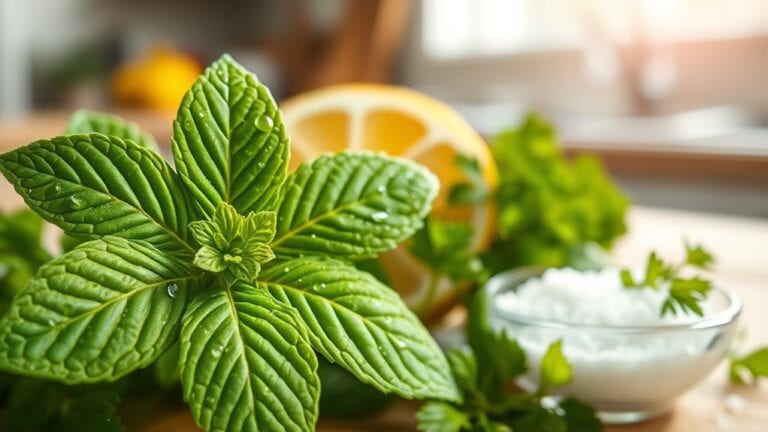Like a concealed key revealing ancient wellness secrets, lobelia has been quietly supporting health for centuries. You may be familiar with it as a vibrant flowering plant, but its real power lies in its ability to ease breathing troubles, calm restless minds, and even help kick stubborn habits. Packed with compounds like lobeline, it’s more than just garden decor—yet using it wisely matters. Want to see how this unassuming herb could fit into your life? The answers could astonish you.
What Is Lobelia?
Lobelia—often called Indian tobacco or puke weed—is a flowering plant with tall green stems and vibrant violet blossoms, mostly found in North America.
You may recognize it by its delicate, tube-shaped flowers or its bitter taste. The active compound in Lobelia, lobeline, gives it its unique properties.
People have used Lobelia for centuries, thanks to its potential health benefits, like easing breathing troubles or calming spasms.
Though it’s powerful, you’ve got to be careful—too much can be harmful. Consider it like a strong spice: a little helps, but too much ruins the dish.
Should you be curious about trying it, talk to a pro initially. Nature’s remedies are amazing, but they need respect.
That’s Lobelia—pretty flowers with a punch.
Historical Uses and Cultural Significance
While Lobelia might seem like just another herb today, its roots run deep in history, woven into the traditions of Native American tribes long before modern medicine took notice. They used it for medicinal purposes, like easing respiratory troubles, and in cultural practices, believing it purified the body and spirit.
Later, herbalist Samuel Thomson championed it as an antispasmodic and emetic, sparking controversy but also expanding its health applications. Though initial Western medicine dismissed it, Lobelia’s historical uses—like inducing vomiting to cleanse toxins—earned it a lasting place in herbal remedies.
Beyond physical healing, tribes valued it for spiritual protection, showing how deeply it shaped both body and belief. Its progression from tradition to acceptance proves its enduring power.
Active Compounds and Nutritional Profile
The power of Lobelia lies in its unique blend of active compounds, each playing a role in its health-boosting effects. You’ll find alkaloids like lobeline, which interacts with your nervous system, potentially easing respiratory spasms and supporting mood. These compounds give Lobelia its therapeutic effects, making it a standout in herbal medicine.
Nutritionally, it’s low in calories but packed with flavonoids and saponins, which might help fight oxidative stress. The seeds, rich in these active compounds, influence neurotransmitter release, subtly balancing your body’s responses.
While it’s not a major source of vitamins or minerals, its strength comes from these specialized ingredients. Just bear in mind, its potency means you should use it carefully—nature’s remedies often work best at the time they’re respected.
Respiratory Health Benefits
Lobelia can assist you in breathing easier by supporting lung function and relaxing tight airways.
Should you struggle with congestion, its expectorant properties might clear mucus and ease coughing.
Even mild breathing difficulties can feel more manageable with its use.
Supports Lung Function
Should you have ever struggled with stubborn congestion or labored breathing, lobelia could be the herb you’ve been missing. Known for its expectorant properties, it helps loosen mucus, making it easier to clear from your lungs.
Should you be handling respiratory disorders like asthma or bronchitis, lobelia’s active compound, lobeline, might relax your airways and ease discomfort. Studies suggest it could even protect against lung injury by reducing inflammation and oxidative stress.
Traditionally, it’s been used to clear irritants by inducing coughing, which helps your body expel blockages safely. You can brew it as a tea or take it as a tincture, but always dose carefully to avoid side effects.
Eases Breathing Difficulties
Once tightness in your chest makes each breath feel like a struggle, lobelia could offer relief by opening up constricted airways. Its active compound, lobeline, helps relax your bronchial tubes, making it easier to breathe deeply.
Should you have ever dealt with asthma or chronic coughing, lobelia’s respiratory health benefits may feel like a lifeline. It works by stimulating your respiratory system, easing breathing difficulties as your lungs feel tight or overworked.
While research is still catching up to traditional use, many find it helpful during flare-ups. Just keep in mind, lobelia isn’t a replacement for emergency care—but it could support your breathing while used wisely.
Always check with a professional before trying it, especially in the event that you have existing conditions.
Clears Mucus Congestion
At the time mucus clogs your airways, every breath can feel like an uphill battle—but lobelia’s natural expectorant properties could help break through that stubborn congestion.
Should you be confronting respiratory conditions like asthma or bronchitis, its active compound, lobeline, works to loosen phlegm, making it easier to cough up and clear mucus congestion.
Studies suggest it relaxes bronchial tubes, improving airflow and easing that tight, suffocating feeling.
Traditional herbalists have long turned to lobelia for lung support, especially as mucus buildup leaves you wheezing or coughing.
It also soothes spasms in your airways, helping you breathe more freely.
Whether you’re fighting a cold or managing chronic issues, lobelia’s gentle yet effective action could be the relief you’ve been searching for.
Effects on Mental Well-Being and Cognitive Function
- Mood Support: Lobeline could ease depression symptoms by balancing brain chemistry.
- Sharper Focus: It might help with attention issues by influencing dopamine levels.
- Memory Boost: Some studies suggest it improves cognitive function, especially in adults.
- Brain Protection: Its antioxidant properties might guard against cognitive decline.
While promising, more research is needed to confirm these benefits.
Should you be curious, talk to a healthcare provider before trying it.
Potential for Addiction Treatment
You may ponder whether lobelia could assist with addiction, and it’s conceivable—lobeline functions similarly to nicotine in your brain, alleviating cravings during quitting.
Research indicates it can aid smoking cessation by influencing dopamine release, but you shouldn’t depend on it solely since evidence is still limited.
Just keep in mind, too much can be harmful, so you’ll want to talk to a doctor before trying it for addiction treatment.
Lobeline and Nicotine Replacement
Because lobeline—a key compound in lobelia—acts similarly to nicotine, it’s been investigated as a potential aid for quitting smoking. While it’s not FDA-approved for smoking cessation, some studies suggest lobeline for smoking could help reduce cravings by affecting the same brain pathways as nicotine.
Here’s what you should know:
- Mimics nicotine: Lobeline binds to nicotinic receptors, which may ease withdrawal symptoms.
- Mixed evidence: Research shows promise, but results aren’t strong enough for widespread use.
- Safety primarily: High doses can be toxic, so always consult a healthcare provider to guarantee safe use.
- Not a standalone fix: It’s best combined with other nicotine replacement strategies for better results.
If you’re considering lobelia, talk to a professional—it’s not a one-size-fits-all solution.
Smoking Cessation Support
The potential of lobelia in smoking cessation doesn’t stop at easing nicotine cravings—it opens the door for broader addiction treatment possibilities.
Lobelia inflata L contains lobeline, which could help reduce withdrawal symptoms by acting like nicotine in your brain. This makes it a natural option for those trying to quit smoking.
However, the FDA banned lobeline-based products due to mixed results and safety concerns. While it seems promising, studies haven’t proven its effectiveness consistently.
Should you be considering it, talk to a doctor initially—high doses can be risky. Though it won’t replace proven methods, Lobelia’s role in addiction research still sparks interest.
Just keep in mind, it’s not a magic fix, but it may offer some support on your path to quitting.
Dopamine Release Effects
Curiosity surrounds lobelia’s ability to influence dopamine, a key player in how we experience pleasure and motivation.
Lobeline, its active compound, interacts with your brain’s reward system in ways that could help with addiction and smoking cessation. Here’s how it works:
- Dopamine Release: Lobeline tweaks dopamine pathways, potentially easing cravings by mimicking nicotine’s effects without the addiction.
- Smoking Cessation: It might reduce withdrawal symptoms, making quitting easier by balancing neurotransmitter levels.
- Broader Addiction Potential: Preliminary research suggests lobeline could help with other substance dependencies by disrupting reward-seeking behavior.
- Focus Support: Some studies hint it could aid ADHD symptoms by stabilizing dopamine, though more research is needed.
While promising, human trials are limited—so tread carefully.
Lobelia’s role in addiction treatment is still unfolding, but its dopamine connection offers hope.
Antioxidant and Anti-Inflammatory Properties
Many of us don’t realize how much oxidative stress and inflammation affect our bodies daily, but Lobelia’s natural compounds might help fight back. Its antioxidant capacity protects your cells from damage caused by free radicals, which can lead to chronic issues should they remain unchecked.
The anti-inflammatory effects of Lobelia could also ease conditions like bronchitis or asthma by calming irritated airways. One key compound, lobeline, shows promise for its neuroprotective effects, potentially shielding brain cells from oxidative stress-induced harm.
By supporting your body’s defenses, Lobelia could play a role in maintaining overall wellness. Consider it as a natural ally against the wear and tear of modern life—quietly working to keep inflammation in check and your cells healthier.
Just keep in mind, moderation is key, as with any natural remedy.
Safe Dosage and Administration
Getting the dosage right with lobelia is key to reaping its benefits safely. Stick to the recommended dosages to avoid side effects like nausea or vomiting. Here’s how to administer it properly:
- Tea: Steep 1/4 to 1/2 teaspoon of dried lobelia in hot water. Don’t overdo it—more isn’t better.
- Tincture: Limit to 0.6 ml per day unless a professional advises otherwise.
- Lobeline Capsules: Up to 30 mg daily seems safe for ADHD support, but research is limited.
- Leaf Consumption: Never exceed 0.6–1 g of lobelia leaves—higher doses can be toxic.
Always start low and go slow. In case you’re pregnant, nursing, or managing health issues, check with a doctor initially.
Safe dosage guarantees you get the perks without the risks.
Possible Side Effects and Precautions
While lobelia can offer several benefits, it’s essential to know the risks so you don’t run into unwanted reactions. Lobelia can cause side effects like nausea, vomiting, or even heart issues should you take too much. The dosage matters—just 1 gram of dried leaves could be toxic, and 4 grams could be fatal. Pregnant or breastfeeding women should avoid it, and in case you have heart problems, talk to your doctor initially.
Here’s a quick guide to stay safe:
| Side Effects | Precautions |
|---|---|
| Nausea, vomiting | Start with small doses |
| Heart rhythm changes | Avoid should you have heart issues |
| High blood pressure | Skip should pregnant or nursing |
| Diarrhea | Consult your doctor initially |
| Fatigue | Never exceed recommended doses |
Always prioritize safety and listen to your body.
How to Incorporate Lobelia Into Your Wellness Routine
Should you be curious about adding lobelia to your wellness routine, there are simple and effective ways to do it without overdoing it. Used in small doses, lobelia can be a gentle yet powerful ally for respiratory health and relaxation.
Here’s how to incorporate it into your day:
- Tea blends: Steep ¼–½ tsp dried lobelia in hot water for 5–10 minutes. Pair it with peppermint or chamomile to soften its bitter taste and boost calming effects.
- Tinctures: Try a diluted tincture (under 0.6 ml daily) for a more concentrated option—always check with a healthcare provider first.
- Herbal mixtures: Mix lobelia with supportive herbs like mullein or ginger to address specific needs while keeping doses light.
- Start low: Begin with tiny amounts to gauge tolerance, then adjust slowly to avoid side effects like dizziness.
Balance is key—listen to your body as you investigate.




